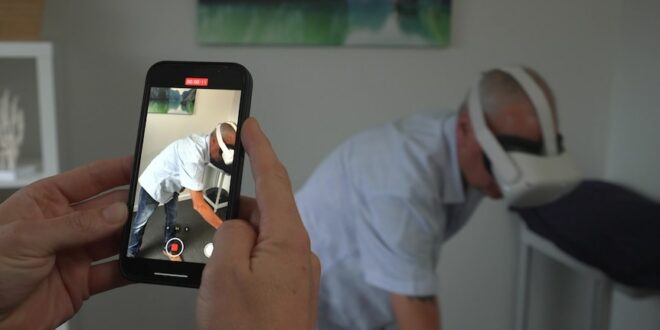In the virtual world, there is no pain.
the main points:
- Commercially available virtual reality technology has been used to combat chronic pain
- Patients put on headphones, receive education about pain, and then complete a series of tasks
- An Adelaide physiotherapist who has tried the technique said it has been very promising so far
But virtual reality may be able to help doctors and physiotherapists treat chronic pain, one of society’s most debilitating health problems.
Using commercially available headsets and phones, Australian company Reality Health has developed a virtual reality program that it hopes will make a big difference in treating chronic pain, the leading cause of disability worldwide according to the Global Burden of Disease Study.
A key part of the program is doing what doctors find most difficult — convincing patients that chronic pain originates in the brain, not from an unhealed injury.
This is something often called “pain system hypersensitivity,” said Lorimer Moseley, a clinical neuroscientist and chair of physiotherapy at the University of South Australia.
“Pain protects us and promotes recovery… persistent pain is overprotective and prevents recovery,” said Professor Moseley, who gave some paid advice to the programme’s developers.
“The pain system becomes overly protective and it actually keeps you from doing the things you need to do to recover.”
Virtual reality software tries to get around this by essentially tricking the patient’s brain into thinking they’re moving less than they really are.
“The positive features of virtual reality are that we are able to change sensory input in the brain and by doing so we can actually change the stimulus that the brain receives,” Nigel Cowan, CEO of Reality Health, told ABC.
“We can reduce sensory input which means the brain is less likely to experience pain and when we combine this with physical rehabilitation therapy it allows patients to progress much faster than they normally would.”
Reality Health asked some physical therapists to try out a virtual reality program on patients interested in the four most common areas of chronic pain: lower back, neck, shoulder, and knee.
Patients wear a headset and receive some education about the pain – where it comes from, how it arises, and why it persists in some cases.
They then complete a series of tasks that require them to move in ways that would normally trigger their pain, but which show them less movement in the virtual world than their actual movement in real life.
Adelaide physiotherapist Leander Pronk, who is piloting the VR program pro bono, told the ABC: “In the virtual environment we can trick their perception a little bit, meaning they can move a lot further than they normally would.”
The doctor then films the patient completing virtual reality exercises, so they can see the difference between their perceived and actual movements upon completion of the session.
“For most of my clients, the results have been amazing,” Pronk said.
“Because they know that pain has less to do with tissue damage as such, and more to do with the brain protecting, and once they realize that pain is just a protective signal, they feel more confident to go this far and sometimes even further.”
Virtual reality is also applicable to a “range of mental health areas”.
Former mechanic John Harris said the virtual reality program helped him deal with chronic back pain that had limited his movement for years.
“I was just blown away,” he said. “It was something I had never tried before.”
“When Leander showed me pictures of me doing it afterward, I was amazed at how far I could go without realizing it.”
The use of VR in healthcare dates back more than two decades, but its previously high cost and limited availability meant there wasn’t much clinical evidence about its effectiveness.
That’s changing now, as cheaper headsets and software make virtual reality more accessible.
Professor Paul Glear, director of the Pain Management Institute at the University of Sydney, who is not involved in developing the VR unit, told the ABC that the technology looked promising.
“It makes a lot of sense in neuroscience, why it would work, and it would be amazing if it didn’t work in clinical trials,” he said.
“It’s definitely an area with a lot of potential and I suppose if it hasn’t already been proven effective compared to some of the other treatments, I’m sure it will be.”
This virtual reality program deals with chronic pain, but its developers hope it can be used for other conditions as well.
“It is now being trialled in a range of mental health areas with virtual reality being used in anxiety and depression,” said Mr. Kwan.
“It’s also used in surgeries and a whole host of activities.”
Originally posted 2022-11-19 09:52:04.
